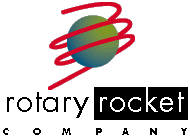Bevin McKinney
 |
|
| Industry | Aerospace |
|---|---|
| Fate | Bankrupt |
| Defunct | 2001 |
|
Key people
|
Gary Hudson Bevin McKinney |
| Products | Roton |
Rotary Rocket Company was a rocketry company that developed the Roton concept in the late 1990s as a fully reusable single-stage-to-orbit (SSTO) manned spacecraft. The design was initially conceived by Gary Hudson, who formed the company to commercialize the concept. The Roton was intended to reduce costs of launching payloads into low earth orbit by a factor of ten.
The company gathered considerable venture capital from angel investors and opened a factory headquartered in a 45,000-square-foot (4,200 m2) facility at Mojave Air and Space Port in Mojave, California. The fuselage for their vehicles was made by Scaled Composites, at the same airport, while the company developed the novel engine design and helicopter-like landing system. A full-scale test vehicle made three hover flights in 1999, but the company exhausted its funds and closed its doors in early 2001.
Gary Hudson's and Bevin McKinney's initial concept was to merge a launch vehicle with a helicopter: spinning rotor blades, powered by tip jets, would lift the vehicle in the earliest stage of launch. Once the air density thinned to the point that helicopter flight was impractical, the vehicle would continue its ascent on pure rocket power, with the rotor acting as a giant turbopump.
Calculations showed that the helicopter blades modestly increased the effective specific impulse (Isp) by approximately 20–30 seconds, essentially only carrying the blades into orbit "for free". Thus, there was no overall gain from this method during ascent. However, the blades could be used to soft land the vehicle, so its landing system carried no additional cost.
One problem found during research at Rotary was that once the vehicle left the atmosphere additional thrust would be necessary. Thus multiple engines would be needed at the base as well as at the rotor tips.
This initial version of the Roton had been designed with the small communications satellite market in mind. However, this market crashed, signaled by the failure of Iridium Communications. Consequently, the Roton concept needed to be redesigned for heavier payloads.
...
Wikipedia
